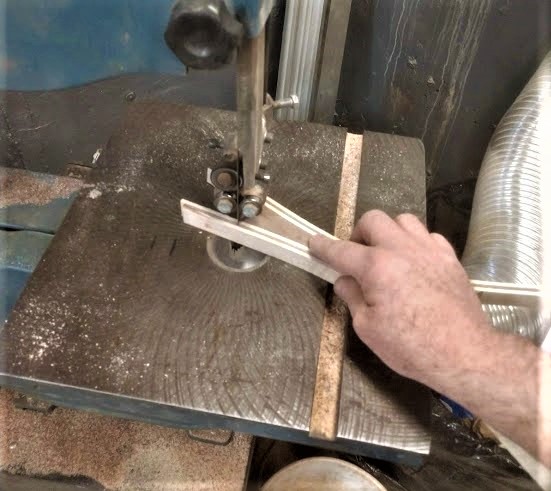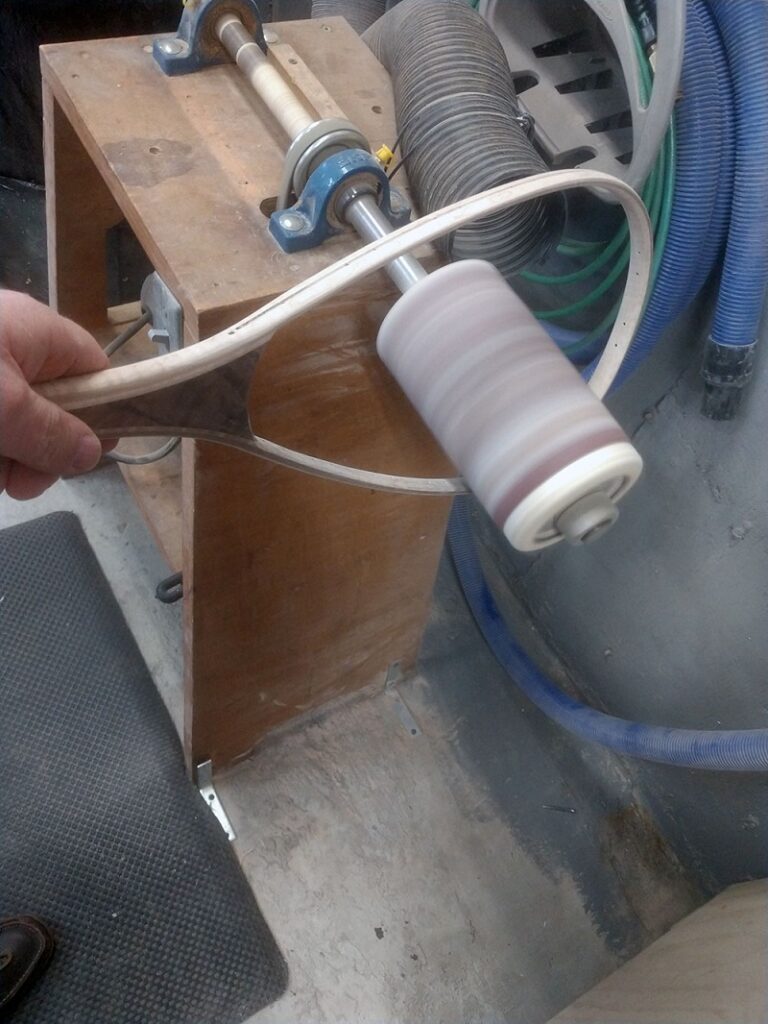Catching fish on a fly rod became an obsession for me some 45 years ago, at the age of twelve. The enjoyment of woodworking set in about the same time. It wasn’t until 16 years later that the two met.
What began as a hobby quickly turned into a small business that blossomed into a full-time job within a few years. I had the privilege and satisfaction of supplying L.L. Bean with landing nets for 10 years before I sold that business in 2003. At that time, I re-entered the building construction trade while searching out the path that I felt God had for me in places of ministry. I now have the privilege of pastoring a small church in central Maine. I have never lost my love for fly fishing or woodworking, and find both to be great therapeutic medicine for the mind. After nearly 18 years of absence from making trout nets, I found my way back, and last year, during the covid wave, began creating a few more nets. It is unlikely I will ever again produce nets in large numbers, I will leave that to the Chris Brodin’s of the world, but the attraction to fly fishing and the wooden net will never leave me.
I’ve never been one to back down from a challenge, and I recall the day I found myself staring at that wooden laminated net on the page of an L.L. Bean catalog and saying to myself, “I can do that…” Though the first frames I made were unrefined, but functional, the journey had begun. With no help from the internet or books, or even a mentor, I began the process of refining my creation and the process of the art. With much encouragement from family and friends, and some needed insight from my creator, I was blessed to develop the process and equipment that I now use to handcraft a product I find great satisfaction in creating.
I do what I do, the way I do it, because it is how I have learned to do it! I have made refinements to my process, learned a few things from the school of hard-knocks, had failures, but have developed the jigs and processes that work for me, and they work well. There is nothing high tech about making a trout net and there doesn’t have to be. Simple woodworking techniques will get the job done. I have no secrets because there are none, but I have discovered a little inspiration and ingenuity from above, and that goes a long way. So, for those of you who may want to blend your love of woodworking with your obsession for fly fishing and have a little something of a homespun woodshop creation, here are a few pointers to get you moving in that direction. For others of you who may simply be curious what it took to create that treasure you stuff in your pack, which photo-bombs the pictures of your catch, I hope you find this at least somewhat interesting. This is the anatomy of a trout net.
Just as I would be shocked to find a fly angler who did not have a great appreciation for the fish they stalk, I would be as surprised to find a woodworker who did not approach that art having a love for the wood with which they create. It all begins there.
Planning is the key to any successful project. Two key elements of this project are the wood you use and the net bag you install. Most woods I have used have been hardwoods, native to the Eastern United states, and for the exception of Walnut, much of it has originated from Maine forests. I have crafted most of my nets using figured maple and walnut along with a significant amount of white ash.
As far as net bags are concerned, the more popular trend of recent years is the rubber bag, but a woven bag of nylon is more than adequate for the task and many prefer this for its lighter weight. The choice is yours, but now is the best time to decide. You can easily find either styles in various places with a simple internet search. At times, net manufactures may even be willing to sell you a bag or two if you approach them with courtesy and respect.

It is important to use strong wood to ensure durability and longevity. Softwoods may be light in weight, but do not hold up well to the abuse a net can often be subject to. I cut strips so that they are sandwiched together and measure anywhere from 5/16” to ½” thick, depending on the overall size of the frame I am building. The strips are cut from 7/8” planed lumber and cut to the length needed for the frame size. Clear, straight grain ash or oak make for a strong frame and bend well when steamed. Laminated strips of most any good hardwood with straight grain and no knots bend well. I even bend figured maple such as birdseye and curly, but with added care where the figured wood may split during the bending process. When I bend, I bend a complete set of strips together. By using a strip of wood with straight grain, the piece intended to be the center lamination, on the outside of the set it holds the figured grain together during the bending process. Once steamed and dried, I have not experienced any issues using figured wood in the frames.

Handles of the nets can be made using most any species of hardwood you would desire. I have a certain selection of woods I used to try and color coordinate with the frame I intended to laminate together. A band saw and drum sander work well for shaping the handle. I especially look for woods with high figure content when making something extra special.

This might be a good place to mention the importance of jigs. My shop is full of them! I take extra special care to make sure my jigs are durable and lasting. I have used plywood before, but plywood has a short lifespan in any type of production work. Hardwood may seem like an expensive jig, but most of the time it is essential, especially when subjected to clamping processes and repetitive contact. Almost all of my jigs that come into contact with adhesives are coated with butcher wax, making them easy to clean. Warning: It will take you longer and require more wood to build your jigs than it will the net. The caveat is this, you will have it to use in the future.

The bending process of making a net requires a steam box. I have had several over the years. My current box is made with a small shop in mind, where I need to store it and don’t need to bend a large quantity at once. This piece of 6 inch box aluminum heated by a pot of boiling water on top of a turkey cooking burner works great, stores easily, and you may just have one sitting in your garage or basement waiting to be used. Several woodworking catalogs also offer steam pumps that work well if you desire to invest in something specialized to bending wood, and they’re not that expensive. I can steam and bend one dozen nets in one sitting with this steamer.

Once the strips have set and dried for a day or two, they are ready to laminate together. Using the primary form and an outer clamping ring glue is applied and c-clamps are used to press the strips together. Gluing one side of the strips is adequate. I use gorilla glue in a roller dispenser because it makes it easy to apply. The glue is a one-part waterproof polyurethane glue. This can be messy and you should not apply this glue without rubber gloves. You can also use epoxy glues, but make sure they are not fast setting epoxies, you will need more time than the fast setting epoxies offer. My outer clamp rings have a compressed piece of 5/8” rubber hose glued to them. This rubber helps apply a more even pressure between the clamps. Built into the ring is a couple pieces of hardwood to match the form of the handle. The handle is also laminated into the frame at the same time. A couple ¾” pony clamps on the handle section ensure a tight glue joint given the jig is built to match the assembly.

The finished frame will be 3/4 inch thick for most frames. Slightly more for large boat nets. It is virtually impossible to assemble the pieces perfectly flush with each other. This is why all stock is prepared 7/8 inch thick and machined from there. Now, all this glue needs to be removed and I have just the machine for that!

This drum sander is just the ticket! You can use a hand belt sander, but it is very tricky to sand the frame to a consistent thickness. One of the benefits of bending a single, solid piece of oak or ash for your frame is that you can prepare it at the desired dimension of 3/4 inch and it does not require the same sanding effort at this point.

Wow, it’s really starting to take shape now. Once the ends are nipped off, and sanded to the desired contour using the drum sander, it is ready to machine.

I use a 1/32 inch slot cutter on the router, with its own jig I’ve designed, to both hold the net tight to the table and determine the depth of the cut. The router is set to cut the slot dead center of the frame. I have also custom shaped the slot cutter, so that it gives me a concave slot rather than a square slot.

I like to relieve the edges of the frame. I do that using a 3/8 inch round-over router bit doing all four edges of the frame: two inside and two outside. This bit is not placed a full height, but adjusted so that it removes just slightly more than the thickness of the laminations on the top and bottom side of the basket portion of the frame. Once the basket is machined, I raise the bit to its full height and router the handle, being careful not to carry the machining to the basket portion of the frame.

I use a 7/64 bit in a Dremel tool to drill the holes. You can make a jig for this process out of a scrap piece of 3/4 inch plywood or something similar, and determine the hole spacing according to the type of net you are using. If you use a traditional loop net, you will want to count the loops and drill the correct number of holes spaced evenly around the jig.

I sand each frame using an inflatable drum sander. This particular sander, I made myself years ago. The air pressure in the drum can be adjusted for sanding the contours of the relieved frame. Two different drum sizes are used in the sanding process before a fine mop head is used to provide the finished sanding. Of course, there is always a bit of hand sanding that machinery cannot duplicate.

Once the net is sanded just so, you have an opportunity to personalize your crafted product. I may burn a logo into the handle, or install an inlay depending on the project. If I am going to place my signature in the net, I usually wait until I have sufficient sealer coats of oil finish on the wood so that the paint pen or gel product remains sharp and is not soaked and smeared into the wood.

The finish that is applied, perhaps has more to say about what you think of your project than any description you can give. You can choose from a variety of products from polyurethanes, spar varnishes, and oils, but the choice is up to you and not any one is perfect. Some can be applied quickly while others require days. You can use natural sheens or hand rubs. It can be simple or it can become complicated. What makes the difference is “patience.” You cannot force any finish, it must be given its due time and used as it was intended. If you do so, it will become the crown of your art.

The net bag is one of the last key elements, and the plan for the net bag you use was likely one of the first decisions you made in the planning of the project. Regardless of the net bag you will use, the bag will be installed using a heavy braided dacron line by tying off to an original point near the throat of the frame. Then, by weaving your way around the frame to the opposite side and tie off at the final point.

Once the net bag has been installed, you are all but ready to hit the stream! There are a couple added attachments you may desire to make, such as a clip at the end of the handle or a magnetic type release. Protecting your creation as well as providing convenient access to it while on your fly fishing journey is key to the satisfaction you feel when you reach and find that thing that was made for this moment! Now, get out there and use it, admire it, and show it off to a few of your fishing acquaintances. They’ll wish they had one just like it. Perhaps someday they will!






